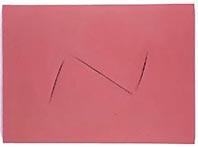 "Hot Line" 1994 - Cartes de visite - 7 x 12 cm Courtesy: Galerie Emmanuel Perrotin Photo: Peggy Leboeuf
Things,Others, and the Outsider His early phase (1987-1989) could be defined as "acquaintance with things." One of his first works was the silhouette of a bicycle propped against a wall. It called to mind a stolen bicycle, his bicycle: art born from a loss, a void to be filled. His first works echoed the forms of design. These projects - lamps, tables, armchairs, etc. - while lacking any functionality, stimulated a renewed con-sideration of the originals' logic. Cattelan was soun-ding the limits separating the idea from its practical application, the real from the fictitious; he promoted the discarded by products of a judicious separation of the authentic from the useless. These objects are interesting for their exchange value, for their communicational dynamics. The work of art is no longer the mise en forme of an inanimate object: the art is information.  Sans titre 1996 Acrylique sur toile 101,5 x 75 cm Courtesy: Galerie Emmanuel Perrotin Photo: Peggy Leboeuf Cattelan's second operative phase, "discovenng others," (1990-1992) was induced by a pressing necessity: the survival of information depends on a system. Even the art world lives and evolves thanks to an art system that is advanced through strategies of communication. Cattelan is convinced that "every system, even the best of all possible systems, contains a margin for error, a chink through which a virus can be introduced." Cattelan, therefore, tried to introduce himself into various systems by various means. He founded a scientific cooperative. He published an advertisement in various Italian newspapers which read, "Your vote is precious, keep it for yourself " He started a soccer team of Senegalese immigrates living in Emilia Romagna, challenging a team composed of art critics and dealers to a playoff on a custom-made table soccer game built to accommodate two teams of eleven players. He set up an illegal stand at an international art fare publicizing his soccer team. One of his gallery exhibitions featured a pyramid built from art magazines - their covers pictured the very same pyramid - whose advertising space he tried to sell. For an exhibition of site-specific works to be held in a Dutch town on the German border he presented a project to distribute posters announcing a Nazi skinhead sit-in to coincide with the opening of the same exhibition. The project was judged too riski and rejected by the curator. Cattelan withdrew from the event thus excluding himself from an important opportunity. From that point on Cattelan, who always maintained a covert style of inquiry, no longer attended the openings of his exhibitions and often canceled the soirees outright. It was as though he considered his physical presence to be superfluous. The very significance of his absence can be considered the key to the third phase of his work: "the clandestine artist" or "the importance of being elsewhere." Back in 1989 Cattelan had already installed a personal displaying only a transparent mailbox and a sign on the wall reading '"Torno subito" (I'll be back soon). For a group show in 1991 he tacked up an official report (signed and registered by the police) denouncing the theft of his artwork the night before the opening. "The work of art," the police report stated, was invisible" (see Twenty Fragile Pieces, 1992).  Sans titre 1996 Chien naturalisé 95 x 60 x 30 cm - 1/1 Courtesy: Galerie Emmanuel Perrotin Photo: Peggy Leboeuf This need to be clandestine was evident to anyone who saw the work he had up at a large 1993 group show: a series of sketches executed by a police artist based on descriptions of Cattelan provided by his friends. The policeman had obviously never seen the face in question, but judging from the resultant portraits (of the type normally used to track down and arrest outlaws) even his closest friends seemed somewhat uncertain of his true physiognomy. The missing work, collective participation, the omission of the artist, alienation, identity problems apparently Cattelan doesn't covet a predetermined role in the art process. Rather he identifies himself with the dynamics of each action. The idea of role is a personal identification problem that, when transferred to an artwork, becomes a sweeping dynamic, challenging any acquired category. In another gallery exhibit the public entered only to find that the artist had left nothing behind but a lion costume for the two resident dealers to wear during the gallery hours as they moved freely through the empty rooms. This feline exhibition was the culmination Cattelan's infiltration into the system. But at the same time it announced the definitive disappearance of the artist, who soon inaugurated another exhibition which remained entirely closed to the public. Visitors found themselves locked out and peaking through the window at a little mechanical bear gliding back and forth across the gallery on a fine metal wire. For an entire year he solicited contributions from 100 generous art world sponsors, tributes to be awar-ded to a "worthy artist," who in the end was none other than Cattelan himself. He used these contributions to commissions a glass plaque - that was illegally mounted on the walls of the Milanese art academy of Brera - bearing the names of the 100 illustrious donors. At the last Biennale in Venice he "sublet" his allotted space to an advetrising agency, which in turn mounted a perfume company's poster. For two shows in a private gallery and in a museum he unloaded a pile of rubble from the ruins of a museum, bombed by unknown assailants. In verifying the possible developments in the relationship between artist and the art system, Cattelan has helped define important distinctions between the denial of preestablished languages and the metaphorical subversion of current interpretations, between the modus operandi and the result, the clandestinity of the outsider and the obliged exhibition, smallscale crime and healthy affirmations, between the requirements of the self and those of the group, the eulogy of escape and the right to be, between the openings that lead to the phenomena of reality and the collateral reverberations of internal turmoil: all necessary dichotomies in the redefinition of the quality of relations between the artist and his/her surroundings. Gianni Romano |